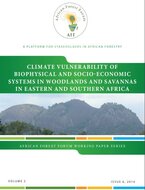Climate change is a major threat to achieving the poverty reduction aspirations of many African countries as well as to the attainment of the Millennium Development Goals (MDGs). It is affecting rainfall patterns, water availability, sea levels, the dynamics of droughts and bushfire frequency. These are increasingly impacting woodland ecosystems, associated livelihoods, human health, agriculture productivity and biodiversity (Munishi et al., 2010; Kowero, 2011). Climate change will therefore adversely affect livelihoods, national incomes and the environment. While woodlands are affected by climate change, they also play key roles in mitigation and adaptation to climate change. These roles may include increasing the resilience of rural communities to climate change and support to species to adapt to changing climate by acting as refuge during adverse climate conditions. Woodlands also indirectly support economies to adapt to climate change by reducing costs of climate-related negative impacts, through provision of goods and services during extreme weather events, and by providing key assets for reducing vulnerability to the effects of climate change. Woodlands play a major role in climate change mitigation as deforestation and forest degradation is estimated to contribute to about 18% of the global carbon dioxide (greenhouse gas – GHG) emissions and have considerable potential to mitigate emissions through carbon sequestration. The major objective of this work was to review available information on climate vulnerability of biophysical (i.e. soil, water, and biological resources) and socio-economic (i.e. human health, livelihoods, products, trade and development) systems in woodlands of Eastern and Southern Africa.
The woodlands of Eastern and Southern Africa are of various types including Miombo Woodlands covering about one-third of the region, Terminalia-Combretum savannah woodlands, Mopane woodland and Zambezi Teak (Baikiaea plurijuga) woodland. Further the Acacia-Combretum woodlands in Zimbabwe and AcaciaCommiphora woodlands in Kenya and Tanzania form major woodland types. The Miombo ecosystem is one of the tropical wildernesses in the world covering about 3.6 million km2 and spanning ten countries in East, Central and Southern Africa (Munishi et al., 2011).
Climate change will have wide-ranging effects on the environment, and on socio-economic and related sectors, including water resources, agriculture and food security, human health, terrestrial ecosystems and biodiversity, woodlands inclusive. The woodlands of Eastern and Southern Africa will be responding to variable rainfall in terms of seasonality and amounts with predominantly decreasing rainfall and increasing temperatures (Munishi et al., 2010). Climate change scenarios for Africa include higher temperatures across the continent estimated to be increasing by 0.2°C per decade (Elagib and Mansell, 2000) and more erratic precipitation. Changes in rainfall patterns are likely to lead to severe water shortages and/or flooding while temperature increases will potentially severely increase rates of extinction for many habitats and species (up to 30 per cent with a 2°C rise in temperature).
Water-related problems, already serious in the region, are likely to worsen as a result of climate change (AMCEN, 2011). Intense rainfall events will increase the incidence of flooding in many areas. At the same time, reduced run-off will exacerbate water stress and reduce the quality and quantity of water available for domestic, crop and livestock use. In a wider context the predicted impacts of climate change on water resources in woodlands of Eastern and Southern Africa indicate that by 2020, between 75 and 250 million people are projected to be exposed to increased water stress. Agricultural production, including access to food, in many Eastern and Southern African countries is projected to be severely compromised due to water scarcity which will further adversely affect food security and exacerbate malnutrition.
The woodlands of Eastern and Southern Africa are diverse and such diverse vegetation would imply a variety of habitats and areas of high species diversity and endemism. Climate change impacts on the woodlands in this region will thus likely impact biodiversity and vulnerable endemic species. Major impacts of climate change on the woodlands include changes within some types and disappearance of others, and changes in species composition. Because climate is a primary determinant of species distributions and ecosystem processes, new climates may promote formation of new species associations and other ecological changes whereas changes in current climates may also increases the risk of extinction of species with narrow geographic or climatic distributions and disruption of existing communities.
Eastern and Southern African woodlands are critical for the well

